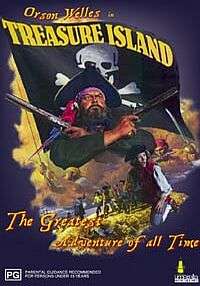Treasure Island (1972 live-action film)
| Treasure Island | |
|---|---|
 Australian DVD Cover | |
| Directed by |
John Hough Uncredited: Andrea Bianchi Antonio Margheriti |
| Produced by |
Artur Brauner Luis Bermejo Carrión Andrés Vicente Gómez François de Lannurien Harry Alan Towers |
| Written by |
Novel: Robert Louis Stevenson Screenplay: Bautista de la Casa Hubert Frank Wolf Mankowitz Anthony Margheretti Gérard Vergez O. W. Jeeves |
| Starring | Orson Welles |
| Music by | Natale Massara |
| Cinematography | Cecilio Paniagua |
Production company | |
| Distributed by | National General Pictures[1] |
Release dates |
|
Running time | 94 min. |
| Language | English |
Treasure Island is a 1972 adventure film, based on the novel Treasure Island by Robert Louis Stevenson. The film stars Orson Welles as Long John Silver, Walter Slezak as Squire Trelawney, Rik Battaglia as Captain Smollett, and Ángel del Pozo as Doctor Livesey. This adaptation of Treasure Island was released in several different language versions, each with a different director.
Plot
Jim Hawkins (Kim Burfield) is a young boy who works at a pub with his mother (Maria Rohm). When a drunken old sailor named Billy Bones (Lionel Stander) comes in for a drink and dies, Jim gets his hands on a map which shows the whereabouts of pirate Captain Flint's treasure. Immediately taking action, he then enlists the help of Squire Trelawney (Walter Slezak) and Dr. Livesey (Angel DelPozo) to join him as he locates the island on the map. Together, they join a ship commanded by Captain Smollett (Rik Battaglia) that will lead them to their destination. Word of the treasure map gets around and most of the crew are recruited with the help of the ship's cook, Long John Silver (Orson Welles), an ex-pirate who had sailed with Captain Flint and intends to get the treasure by mutiny and murder. Already on the island is a marooned pirate, Ben Gunn, who has spent his time on the island gathering the treasure. With his help Jim, the Squire, the Doctor, the Captain and a number of loyal crewmen outwit the pirates, killing most of them in gun battles. Silver is captured, but escapes, when the ship reaches harbour in the West Indies. Much of the plot and the linking narrative - spoken by Jim Hawkins - is faithful to the original book.
Cast
- Orson Welles as Long John Silver
- Kim Burfield as Jim Hawkins
- Lionel Stander as Billy Bones
- Walter Slezak as Squire Trelawney
- Ángel del Pozo as Doctor Livesey
- Rik Battaglia as Captain Smollett
- Jean Lefebvre as Ben Gunn
- Maria Rohm as Mrs. Hawkins
- Paul Muller as Blind Pew
- Jean Lefebvre as Ben Gunn
- Michel Garland as George Merry
- Aldo Sambrell as Israel Hands
Production
The film had its origins in Orson Welles's attempts to film his Shakespearean play Chimes at Midnight in the early 1960s – a project he had worked on since the late 1930s. After Welles had failed to convince numerous producers to finance his film, he tried an alternative approach: he wrote a screenplay for the more commercially appealing Treasure Island, and promised to make both films, back to back, filmed on the same sets and with the same cast, for barely more than the cost of one film. As well as having written the script, he proposed to direct Treasure Island and play Long John Silver. This approach worked; Spanish producer Emiliano Piedra agreed to finance both films, and colour filming on Treasure Island by Welles actually began in 1964 (while Chimes at Midnight was simultaneously shot in black and white). However, Piedra's interest in Chimes at Midnight was minimal, and when Welles felt he was being given inadequate resources for the Chimes shoot, he began appropriating resources from Treasure Island to be able to complete the more cherished project. Treasure Island was thus effectively abandoned after a few days of filming. However, Welles remained contractually tied to the project as both actor and writer, and eventually, eight years later, he was brought in to make the film for the director John Hough. Once again, it was filmed entirely on location in Spain, with a Spanish crew. Welles was sufficiently dismissive of the rewrites to his original script that he asked not to be credited, taking the pseudonym "O.W. Jeeves".[2]
Although in the 1960s Welles had much enthusiasm for making a version of Treasure Island, he apparently thought little of the eventual 1972 production. In a 1979 interview Welles claimed his voice in the film was redubbed by another actor. In some versions he was dubbed by Robert Rietti.
References
- ↑ http://www.imdb.com/title/tt0069229/companycredits?ref_=tt_dt_co
- ↑ Jean-Pierre Berthomé and Francois Thomas, Orson Welles at Work (Phaidon, London, 2008) pp. 254, 257